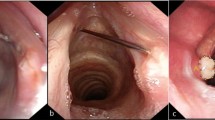Abstract
Objective
To evaluate the short-term efficacy of transcutaneous glucocorticoid injection for laryngeal contact granuloma in females.
Methods
A total of 14 female patients with laryngeal contact granuloma treated in our outpatient department from November 2017 to January 2020 were included in the study. Inspiratory-phase laryngoscopy images were collected before treatment and 1 month after each injection, and the lesion size was measured and evaluated with ImageJ software.
Results
Two patients achieved complete remission after one injection, with a percent reduction of 100%. After two injections, 4 patients achieved complete remission, with a percent reduction ranging from 96% to 100%. After 3 injections, 4 patients achieved complete remission (including one patient with bilateral lesions), and the percent reduction ranged from 95% to 100%. Three patients achieved incomplete remission, with a percent reduction of 46%, 55%, and 81%, respectively. In one case, there was no remission, and the granuloma increased in size after treatment.
Conclusion
In women with laryngeal contact granuloma, transcutaneous glucocorticoid injection therapy can quickly resolve the granuloma in a short period.



Similar content being viewed by others
References
Jackson C (1953) Contact ulcer granuloma and other laryngeal complications of endotracheal anesthesia. Anesthesiology 14(5):425–436. https://doi.org/10.1097/00000542-195309000-00001
Wang CT, Lai MS, Hsiao TY (2015) Comprehensive outcome researches of intralesional steroid injection on benign vocal fold lesions. J Voice 29(5):578–587. https://doi.org/10.1016/j.jvoice.2014.11.002
Wang CT, Lai MS, Lo WC, Liao LJ, Cheng PW (2013) Intralesional steroid injection: an alternative treatment option for vocal process granuloma in ten patients. Clin Otolaryngol 38(1):77–81. https://doi.org/10.1111/coa.12021
Wang CT, Lai MS, Cheng PW (2017) Long-term surveillance following intralesional steroid injection for benign vocal fold lesions. JAMA Otolaryngol Head Neck Surg 143(6):589–594. https://doi.org/10.1001/jamaoto.2016.4418
Wu PH, Cheng PW, Lin FC, Wang CT (2018) Intralesional steroid injection as an alternative treatment for 57 patients of vocal fold mucus retention cysts. Clin Otolaryngol 43(5):1375–1378. https://doi.org/10.1111/coa.13137
Hsu YC, Liao LJ, Huang TW, Wang CT (2019) Assessment of patient outcomes after adjuvant vocal fold steroid injection for fibrosis after microlaryngeal surgery. JAMA Otolaryngol Head Neck Surg. https://doi.org/10.1001/jamaoto.2019.1682
Rhen T, Cidlowski JA (2005) Antiinflammatory action of glucocorticoids–new mechanisms for old drugs. N Engl J Med 353(16):1711–1723. https://doi.org/10.1056/NEJMra050541
Wang CT, Liao LJ, Cheng PW, Lo WC, Lai MS (2013) Intralesional steroid injection for benign vocal fold disorders: a systematic review and meta-analysis. Laryngoscope 123(1):197–203. https://doi.org/10.1002/lary.23551
Wani MK, Woodson GE (1999) Laryngeal contact granuloma. Laryngoscope 109(10):1589–1593. https://doi.org/10.1097/00005537-199910000-00008
Wang CP, Ko JY, Wang YH, Hu YL, Hsiao TY (2009) Vocal process granuloma–a result of long-term observation in 53 patients. Oral Oncol 45(9):821–825. https://doi.org/10.1016/j.oraloncology.2009.01.008
Hong-Gang D, He-Juan J, Chun-Quan Z, Guo-Kang F (2013) Surgery and proton pump inhibitors for treatment of vocal process granulomas. Eur Arch Otorhinolaryngol 270(11):2921–2926. https://doi.org/10.1007/s00405-013-2527-8
Devaney KO, Rinaldo A, Ferlito A (2005) Vocal process granuloma of the larynx-recognition, differential diagnosis and treatment. Oral Oncol 41(7):666–669. https://doi.org/10.1016/j.oraloncology.2004.11.002
Horiguchi S, Suzuki M, Takagi H, Yamanishi T, Nakamura K (2001) Clinical course of laryngeal granuloma without surgical treatment. Diagn Ther Endosc 7(3–4):129–133. https://doi.org/10.1155/DTE.7.129
Lemos EM, Sennes LU, Imamura R, Tsuji DH (2005) Vocal process granuloma: clinical characterization, treatment and evolution. Braz J Otorhinolaryngol 71(4):494–498. https://doi.org/10.1016/s1808-8694(15)31205-2
Ylitalo R, Lindestad PA (2000) Laryngeal findings in patients with contact granuloma: a long-term follow-up study. Acta Otolaryngol 120(5):655–659. https://doi.org/10.1080/000164800750000504
Shimazu R, Kuratomi Y, Aoki S, Inokuchi A (2014) Laryngeal granuloma in experimental rats with gastroesophageal reflux disease and mechanically injured vocal cord mucosa. Ann Otol Rhinol Laryngol 123(4):247–251. https://doi.org/10.1177/0003489414525018
Koufman J, Sataloff RT, Toohill R (1996) Laryngopharyngeal reflux: consensus conference report. J Voice 10(3):215–216. https://doi.org/10.1016/s0892-1997(96)80001-4
Shoffel-Havakuk H, Halperin D, Yosef L, Feldberg E, Lahav Y (2014) Lesions of the posterior glottis: clinical and pathologic considerations and treatment outcome. J Voice 28(2):263.e1-263.e8. https://doi.org/10.1016/j.jvoice.2013.08.013
Pontes P, De Biase N, Kyrillos L, Pontes A (2001) Importance of glottic configuration in the development of posterior laryngeal granuloma. Ann Otol Rhinol Laryngol 110(8):765–769. https://doi.org/10.1177/000348940111000812
Havas TE, Priestley J, Lowinger DS (1999) A management strategy for vocal process granulomas. Laryngoscope 109(2 Pt 1):301–306. https://doi.org/10.1097/00005537-199902000-00023
de Lima Pontes PA, De Biase NG, Gadelha EC (1999) Clinical evolution of laryngeal granulomas: treatment and prognosis. Laryngoscope 109(2 Pt 1):289–294. https://doi.org/10.1097/00005537-199902000-00021
Roh HJ, Goh EK, Chon KM, Wang SG (1999) Topical inhalant steroid (budesonide, Pulmicort nasal) therapy in intubation granuloma. J Laryngol Otol 113(5):427–432. https://doi.org/10.1017/s0022215100144147
Jaroma M, Pakarinen L, Nuutinen J (1989) Treatment of vocal cord granuloma. Acta Otolaryngol 107(3–4):296–299. https://doi.org/10.3109/00016488909127512
Ylitalo R, Lindestad PA (1999) A retrospective study of contact granuloma. Laryngoscope 109(3):433–436. https://doi.org/10.1097/00005537-199903000-00017
Jin YJ, Lee SJ, Lee WY, Jeong WJ, Ahn SH (2014) Prognostic factors for prediction of follow-up outcome of contact granuloma. Eur Arch Otorhinolaryngol 271(7):1981–1985. https://doi.org/10.1007/s00405-014-2915-8
Pham Q, Campbell R, Mattioni J, Sataloff R (2018) Botulinum toxin injections into the lateral cricoarytenoid muscles for vocal process granuloma. J Voice 32(3):363–366. https://doi.org/10.1016/j.jvoice.2017.06.006
Yumoto E, Sanuki T, Miyamaru S, Kumai Y (2008) Does subepithelial hemorrhage cause persistence of laryngeal granuloma? Laryngoscope 118(5):932–937. https://doi.org/10.1097/MLG.0b013e318163819b
Funding
No funding was received.
Author information
Authors and Affiliations
Corresponding author
Ethics declarations
Conflict of interest
No authors have any conflicts of interest.
Additional information
Publisher's Note
Springer Nature remains neutral with regard to jurisdictional claims in published maps and institutional affiliations.
Rights and permissions
About this article
Cite this article
Zhang, R., Li, J., Nie, Q. et al. Short-term outcome of transcutaneous glucocorticoid injection for laryngeal contact granuloma in females. Eur Arch Otorhinolaryngol 278, 1499–1504 (2021). https://doi.org/10.1007/s00405-020-06595-3
Received:
Accepted:
Published:
Issue Date:
DOI: https://doi.org/10.1007/s00405-020-06595-3




